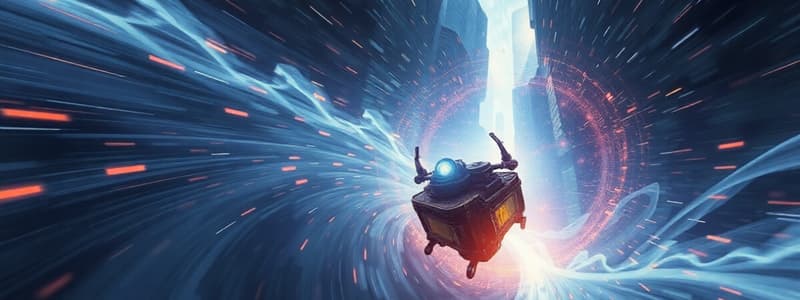Podcast
Questions and Answers
A book rests on a table. Which type of friction primarily prevents the book from moving unless a significant force is applied?
A book rests on a table. Which type of friction primarily prevents the book from moving unless a significant force is applied?
- Static friction (correct)
- Sliding friction
- Fluid friction
- Applied friction
Which of the following scenarios exemplifies a non-contact force?
Which of the following scenarios exemplifies a non-contact force?
- A hand pushing a door open.
- A magnet attracting a paperclip. (correct)
- A car's tires pushing against the road to accelerate.
- A rope pulling a box across the floor.
How does increasing the distance between two objects affect the gravitational force between them?
How does increasing the distance between two objects affect the gravitational force between them?
- Gravitational force increases linearly with distance.
- Gravitational force increases exponentially with distance.
- Gravitational force decreases linearly with distance.
- Gravitational force decreases. (correct)
An astronaut has a mass of 55kg. If their weight on Earth is 539N, which variable would change most significantly if the astronaut were on the Moon?
An astronaut has a mass of 55kg. If their weight on Earth is 539N, which variable would change most significantly if the astronaut were on the Moon?
A skydiver is falling through the air. Which type of friction is primarily opposing their motion?
A skydiver is falling through the air. Which type of friction is primarily opposing their motion?
Two objects are in contact. What must occur for sliding friction to be present?
Two objects are in contact. What must occur for sliding friction to be present?
Which of the following describes the relationship between mass and gravitational force?
Which of the following describes the relationship between mass and gravitational force?
A box is pushed with 200N of force, but only accelerates due to a 70N force. What best explains the difference?
A box is pushed with 200N of force, but only accelerates due to a 70N force. What best explains the difference?
Flashcards
Force
Force
A push or pull on an object.
Contact Force
Contact Force
A force that requires direct contact between objects.
Non-Contact Force
Non-Contact Force
A force that acts between objects without direct contact.
Friction
Friction
Signup and view all the flashcards
Static Friction
Static Friction
Signup and view all the flashcards
Sliding Friction
Sliding Friction
Signup and view all the flashcards
Fluid Friction
Fluid Friction
Signup and view all the flashcards
Gravity
Gravity
Signup and view all the flashcards
Study Notes
- Forces change the motion of an object
Gravity and friction
- Contact forces and non-contact forces exist
- Friction affects the motion of two objects sliding past each other
Types of Forces
- A force is a push or pull on an object
- Contact forces involve a push or pull on one object by another that is touching it
- Non-Contact forces involve a push or pull on one object by another without touching it
- Gravity, magnetic and electrical forces are examples of non-contact forces
Types of Friction
- Friction is a force that resists the motion of two objects that are touching
- Static friction prevents objects from sliding past each other
- Sliding friction opposes the motion of objects sliding past each other
- Fluid friction is friction between a surface and a fluid, like water or air (air resistance)
Static vs. Sliding Friction
- Net force is 0N in static friction when the static friction (-100N) and the applied force (100N) cancel each other
- Applied force is 100N in static friction
- Sliding friction -70N with applied force of 200N
Gravity
- Gravity is an attractive force that exists between all matter
- Mass is the amount of matter in an object
- More mass results in a greater gravitational pull
- The greater the distance, the less gravitational pull
Weight vs. Mass
- Weight is the amount of gravitational force
- An astronaut weighs 539N and has a mass of 55kg on Earth
- On the moon, the astronaut's weight would be less
Electrical Force
- Static charge is unbalanced positive or negative charge on an object.
- Opposite charges attract each other
- The same charges repel each other
- The more the charge, the greater the electrical force (attraction or repulsion)
- The more distance, the less electrical force
Magnetic Force
- A magnet is an object that attracts metal iron
- A magnetic pole is the place on a magnet where the force it applies is the strongest
- Opposite poles (charges) attract each other
- The same poles (charges) repel each other
- Variables that affect magnetic strength include the size of the magnet and distance
- The further away the magnets are, the weaker the magnetic force
Studying That Suits You
Use AI to generate personalized quizzes and flashcards to suit your learning preferences.
Related Documents
Description
Explore how forces change motion, differentiating between contact and non-contact forces such as gravity. Understand the effects of friction on sliding objects and the types of friction: static, sliding, and fluid. Learn about balanced forces in static friction.




